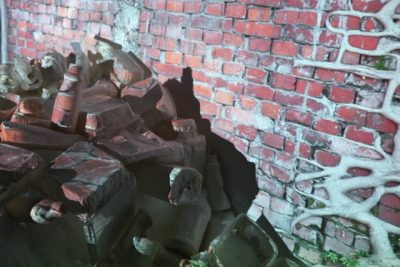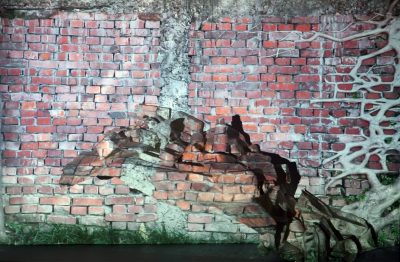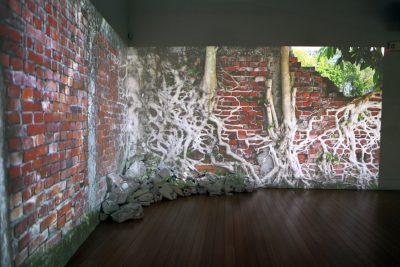Acrylics, turpentine, oil-based paints, gesso and reams of paper.
Art supplies–really just dressed-up toxins–are a mainstay of making great art. As for the unfortunate leftovers, said stuff might be poured down a drain or abandoned to a refuse pile.
Silver Spring-based artist Rachel Schmidt aspires to help change this mindset. Her installation “Shadow Builders,” created of recycled tissue paper, is on view through Jan. 7 at VisArts in Rockville.
The exhibit will feature three separate large-scale installations, each using projected video footage taken during her recent stay in Taipei, Taiwan, onto sculptural forms in space.
“Drowning” is a multimedia installation completed in 2017 that features looped masked video footage of a fish pond projected onto hundreds of paper objects cast from the artist’s plastic waste. This installation is set in a 30-by-20-foot room with a 15-foot ceiling and uses five projectors.
“Rachel confronts her responsibility as an environmentalist, conservationist and artist. Working in sustainable ways is really difficult,” said Susan Main, VisArts’ gallery director and curator. “Every individual, artist or not, who commits to a sustainable practice must wrestle with the realization” that “ultimately, [we] are responsible for and unfortunately complicit in the degradation of the planet.”
Even with all the green-is-good talk, many “artists whose subject may be the environment don’t follow these practices,” said Karyn Miller, Arlington Arts Center’s (AAC) director of exhibits. During Schmidt’s five-year residency at AAC, Miller observed her experimentation and progression as an artist.
Fortunately, Schmidt walks the walk, but also makes art. It is “much more than being sensitive to the environment. She isn’t didactic; her work is magical, pulling you in. She doesn’t want to be a teacher; her work is poetic,” Miller noted.

Schmidt became interested in sustainability after earning a bachelor of fine arts degree from the University of Kansas and a master’s degree from Maryland Institute College of Art’s Mount Royal School of Art in 2007. For the last 10 years, Schmidt has been exploring “futuristic visions of a world without a natural ecosystem, where a synthetic biology governs how people relate and coexist.”
One of her recent installations, “Endless Banquet,” allowed visitors to walk around a darkened dinner table while hearing the sounds of classical music, muffled small talk and the clink of glasses and cutlery. Video footage of a great white shark circles the walled-off dinner party, gliding in and out of the crystalline stemware. For the artist, this haunting installation represents our seemingly limitless practice of consumerism and its effect on the natural world, but it also has the sorrowfulness of a funeral fugue.
Schmidt’s work is full of these types of emotions. The artist is always asking how the “role of myth will play in this future world, and how will the action of myth building take form and evolve? How will a vanishing ecosystem manifest itself in the awareness and scarcity of our material world?”
Schmidt contends that we are living in the Anthropocene Age, defined as the first time in history that human activity has caused mass extinctions of plant and animal species, polluted the oceans and altered the atmosphere. Atmospheric chemist and Nobel Laureate Paul Crutzen first used the term in 2000.
“Tension” is a multimedia installation completed in 2017 that contains several flat wooden sculptures with pulsing LED lights that are spread throughout the space. The wall mounted sculpture has a single channel looped video projected onto it that features content from an artist residency in Taipei, Taiwan. This installation is set in a 30-by-23-foot room with a 15-foot ceiling.
Schmidt’s desire to combine these issues with fantasy was heightened after her three-month residency at the Taipei Artist Village earlier this year. She spent much of her time walking through the labyrinth of urban and rural spaces.
“Taipei is a pretty incredible city, with natural spaces spread throughout the urban landscape. I fell in love with Taipei immediately and found that exploring the city was such an inspiration,” she said. “All of the video content for ‘Shadow Builders’ features video footage I gathered while in Taipei and some of the physical materials I work with, such as the cast paper, are based on experiments I started while there.”
The artist said she was drawn to places where the battle for space is at its most active, recalling “a water pipe being torn open by ivy, a building nestled into the side of a mountain.” Whether these spaces are created by accident or perhaps by necessity, she believes these “tension spaces offer prophetic views of what urban living will evolve into for many species.”

While in Taipei, Schmidt was deeply disturbed to see Asian elephants treated as carnival rides and still doing physical labor. Returning from her trip, the artist created a haunting video, “Future Myths,” about a giant Asian elephant roaming above and around a ruined city, often in the company of a young boy. Was the elephant finally free of human subjugation or simply waiting to be chained up again?
The artist realized that simply pointing out the horrors of environmental degradation can appear heavy-handed and trite. “I don’t want my work to be overly politicized,” she said. She takes the fine line seriously.
Schmidt also has an adventurous side. She recalls honeymooning in the Ukraine during its revolution in 2004; fortunately, the couple was far from the action. It all started when she and her husband, Adrian Erlinger, opted to use their wedding gift money, about $2,000, for travel. Their one caveat was that their destination had to be “someplace where beer is cheap” she said. The couple landed in the Ukraine, where a beer could be had for a quarter.
After some six months, the newlyweds came back to the U.S., and settled in Takoma Park for Erlinger’s career. Schmidt worked as an art handler at the Hirschhorn Museum, proudly noting her prowess in maneuvering a forklift. She now freelances, creating installations at museums and galleries throughout the region.

The artist is hopeful, observing that scores of white tail deer and red-shouldered and red-tailed hawks have adjusted to the region’s urban ecosystem. And she continues to adapt her work for the future. Schmidt believes creating projection-based visuals that can be screened on a wall or fabric, creating an installation, has potential for many artists.
Little by little, the art world may be changing, with programs such as the Maryland Institute of Art’s Concentration in Sustainability and Social Practice, Main said. The first of its kind among art colleges, it “allows visual artists to connect their creative practice to the issues of sustainability including the environment, economy and social justice,” Schmidt explained.
“I want to show all over the world,” she said, “and a 500-pound art piece that needs to be packed and shipped will become less viable over the years.”
She imagines artists considering a simple solution: email the content and instructions to a gallery and they can project the art on a wall.
“Rachel Schmidt–Shadow Builders” is on view through Jan. 7 in VisArts’ Kaplan Gallery, 155 Gibbs Drive, Rockville. The gallery is open Wednesday and Thursday, noon to 4 p.m.; Friday, noon to 8 p.m., and Saturday and Sunday, noon to 4 p.m. An opening reception and artist talk is set for 7 to 9 p.m. Friday, Dec. 1. Call 301-315-8200 or visit www.visartscenter.org. For a look at the artist’s videos, visit www.rachel-schmidt.com. Learn more about this exhibit on CultureSpotMC here.